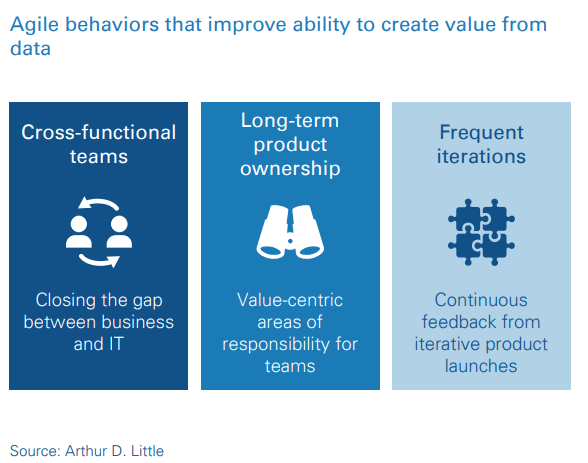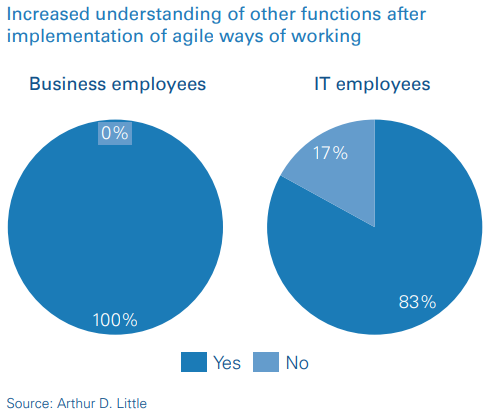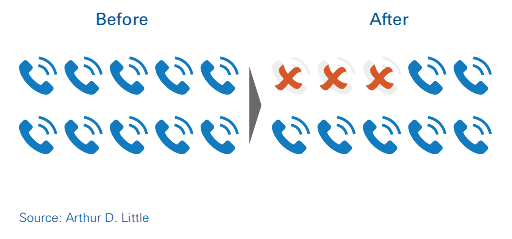
DOWNLOAD
DATE
Contact
In today’s digital environment, companies and their customers are generating increasing amounts of data. Correctly interpreted and used, this overload can be a means of competitive differentiation. It can improve understanding of customers and their behaviors, as well as control of internal processes. However, in many cases, the amount of data is so large, and the nature of it so complex, that it is difficult to analyze and act upon. As a result, many companies do not manage to harvest the potential value of existing data, despite significant investments and efforts. This viewpoint aims to provide a brief description of how agile ways of working can help companies to effectively and efficiently leverage data in their day-to-day operations.
In recent assignments, Arthur D. Little has been exposed to many clients facing challenges in how to utilize their growing amounts of data.
“We have so much data about our performance and our customers; still, we struggle to make use of it.”
Often, organizations can easily collect and store data on, for example, how customers are using and interacting with their products, the effectiveness of various sales channels, and incidents related to product quality, but still fail to create value from it. There are various ways to approach the challenge, however: our recent experience from client casework shows that implementation of agile ways of working is an effective means to improve data utilization. Our empirical evidence leads us to conclude that there are several benefits from agile ways of working:
- Improved understanding of which data to collect.
- Improved understanding of how to interpret data.
- Faster and better solutions to problems, or opportunities arising from data analyses.
- Increased sense of product ownership, which, in turn, creates an incentive to better leverage data.
Why do agile ways of working provide access to the value of data?
Several fundamental agile principles drive behaviors which also improve organizations’ ability to make use of their data. In particular, three agile behaviors are key for identifying and analyzing data, and eventually designing a solution. From an agile perspective, such behaviors are elementary components of any implementation.

1. Cross-functional teams
Agile teams are, by nature, cross-functional, including both business and IT competencies. Combining these competencies, which typically are placed in functional silos, improves quality of decision-making in the organization. On the one hand, the business-resources understanding of the technology improves, and on the other hand, IT resources get better understanding of the overall business and customer needs.
The eventual results are concrete and impactful, with outcomes normally leading to higher customer satisfaction, increased conversion rates in digital interfaces, and less incidents reported to customer service.
The hypothesis behind a cross-functional team is that business representatives with deeper understanding of a company’s technical infrastructure are better positioned to understand which data can be extracted, and how it can best be leveraged to improve quality of decision-making. Similarly, IT representatives get improved understanding of business objectives and customer needs, which helps them to better identify which data to leverage from a business perspective.
At an Arthur D. Little client organization that recently implemented agile ways of working, 100 percent of business stakeholders said they had gained better understanding of the IT infrastructure, and 83 percent of IT co-workers said they had better understanding of business objectives compared to before the agile implementation. In addition, when these two competence areas worked together daily, they would leverage insight from a broader area of operations and develop simple solutions to seemingly complex problems. Such solutions had previously been difficult to develop, if possible at all, as they required both guidance and project leadership from both functions.

Case example
One European telco managed to reduce the number of calls from new customers to its customer service center by 30 percent as a result of implementing agile, cross-functional teams.
Reduced number of calls from new customers to customer service

Historically, the business representatives had had access to call logs and customer service data, but no understanding of the technical complexities that had caused customers’ incidents. IT representatives, on the other hand, had understood the underlying technical issues, but had not possessed the insight to prioritize the technical issues that had caused the most friction for users, or the mandate to make the needed technical improvements. By combining insight and knowledge from IT and customer understanding from business representatives, the cross-functional team identified the issues causing many of the incidents. It also turned out that many issues were relatively easy to address from a technical perspective. However, in some cases, it was too complex or costly to make a direct change, but instead, the problem could be solved through simple workarounds. As a result, customer-incident service calls were significantly reduced, and the costs incurred to address the issues decreased.
2. Long-term product ownership
Agile teams, in contrast to traditional project teams, tend to stay together for longer periods of time and have longterm ownership of the deliverables within their areas of responsibility. This way of working enables and promotes a sense of ownership over the outcome, as well as enabling closer linking of the performance metrics for the teams’ areas of responsibility. In addition, ownership of their areas of responsibility gives teams a clear mandate to decide upon and implement improvements. By defining value-centric areas of responsibility and assigning teams to them, it becomes possible to set outcome-centric objectives and KPIs for each team or grouping that are fully aligned with the organization’s strategic goals. This is in contrast to traditional, output-centric KPIs, which simply measure quantity of output rather than impact of deliverables from the customer’s perspective. In this way, each group’s contribution to the overall corporate strategy becomes clearer to all involved parties, including managers and developers. Each group is then responsible for achieving its targets and given the mandate to make decisions required to reach them – which thus ensures that operative decisions are made by individuals who also have a detailed understanding of how the product delivers its desired outcome. For instance, a single team that is responsible and accountable for the customer satisfaction of its product also has the mandate to prioritize and implement any proposed changes aimed at increasing customer satisfaction.
Case example
An Arthur D. Little client organization saw a 17 percentplus increase in customer satisfaction in its digital interfaces after letting a team have long-term ownership of customer experience for a particular phase of the customer journey. Previously, improvements in customer experience had been performed sequentially. First, business developers had tried to define customers’ needs and the best corresponding solutions. The solution design would then be handed over to development for implementation. Eventually, when insight was available on how well the new solution was meeting customers’ needs, the business developers would usually move on to new projects and have little interest in the feedback available. As a result, valuable insight and learnings had been wasted, as nobody had been accountable for them.
When the client implemented agile ways of working, it gave one cross-functional team end-to-end responsibility and accountability for the digital customer experience for a specific phase of the customer life cycle. This encompassed understanding customer needs, designing and implementing the customer experience in the relevant area, and using insight and feedback as one key lever for improvement. The team made it their common mission to understand what the customer wanted, leveraging both qualitative and quantitative data. After forming initial hypotheses, they tested various solutions to the problems, gathered additional data, refined their hypotheses and tested new solutions until they reached their objectives
The mind-set of the team members improved as a result of the newfound mandate, and they expressed a sense of accountability. Consequently, the team started to proactively analyze KPIs and gain insight to support decision-making, instead of viewing KPIs as tools only for progress reporting.
3. Frequent iterations
Agile workflows are performed in cycles based on short development iterations – so-called sprints. Continuous evaluation of completed work and adjustments of plans are integral parts of every sprint. This way of working allows for data-driven experimentation, from which learnings can be drawn quickly, and at low cost and risk. As a result, improvements can be implemented quickly, in small (low-cost, low-risk) increments.
The process of going from a state of pure data to meaningful impact requires an organization to: 1) collect data; 2) interpret the data to build insight; 3) use the insight to fine-tune its strategic direction; 4) change operational output to support a new strategic direction. However, even data-mature organizations that are aware of customer needs and market trends, and set strategies accordingly, often fail to convert strategy into tangible product improvements. Even when awareness of what is needed is high in some parts of the organization, the time to finish ongoing projects and plan for new output is too long. In contrast, an agile development process can quickly deliver new product increments due to the short development cycles. These iterations allow development teams to adjust their efforts based on any novel insight into customer needs that has been gathered since the last release.
In addition, the ability to rapidly convert data into an impactful outcome promotes a culture of experimentation. When learnings can be drawn and improvements implemented quickly, the cost of failed experiments is low, and so is the risk. Therefore, organizations with rapid, data-driven feedback loops can afford to experiment and innovate, with manageable risk. It is also worth remembering that despite the risks being low, the potential payback can be very high. Experiments conducted with low risk at small scale can quickly be rolled out to a broad customer base if results are positive.
Case example
An Arthur D. Little client organization that implemented short development cycles – iterations – to convert insight into product improvements managed to increase customer satisfaction among mobile app users by 23 percent. In this case, the data on how product launches affected the customer experience was already available in the organization. The required change was to make sure improvements always built upon, or could be validated by, data-driven insight. This example illustrates how small adjustments to ways of working can create a learning organization that becomes used to: i) always using customer feedback; ii) quickly translating it into product improvements; and iii) continuously launching incremental improvements.
Furthermore, by using the type of experimental approach described, the same client reaped the full benefit of an increased conversion rate of 24 percent in digital interfaces for e-commerce. The experimental approach allowed the company to find a solution that customers preferred, rapidly and at low cost.
Conclusion
Implementing agile ways of working is a means for organizations to accelerate their effective and efficient use of data. The benefits that can be drawn are significant, while both the risks and costs are relatively low.
Key components of agile ways of working that companies should implement are:
- Cross-functional teams, in which business and IT representatives meet and leverage each other’s knowledge, as well as each other’s data assets.
- Long-term, value-centric product ownership in which each group’s objectives and KPIs have a clear connection to the overall strategies, and in which responsibilities, as well as mandates, have been delegated.
- Frequent iterations, with launches of small and new service increments and insight-driven evaluation in each cycle, which allow for continuous improvements and experimentation.
Companies that implement the above-mentioned components will quickly develop competitive advantages over those that remain unable to act upon the overload of data in their organizations.



